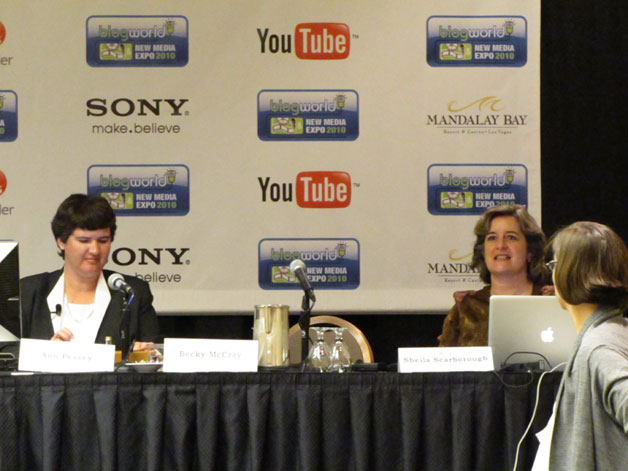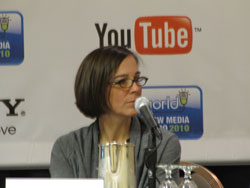You can look at the tourism industry and get a feel for the problems companies of all kinds are facing in terms of social media engagement every day. I just sat in on a session at BlogWorld aimed at such companies, but the themes were much broader – how to filter though all the noise of the web to find discussions about your brand, ways to harness the social media tools that are available to us to actually get some use out of them, how to use different kinds of search engines to engage with people, etc.
When businesses think of search marketing, they tend to think about things like SEO and paid search, but there is another critical element of search – monitoring. You want to monitor your brand using search engines, and while reputation management certainly plays into this, it’s not just about reputation management, it’s about finding where people are talking about your brand and finding ways to engage with them. This not only humanizes your brand (a theme we’ve discussed a lot recently, based on various talks from the Inbound Marketing Summit), but can also help you be there for people when they need you. The conversations that are happening really dictate the solution that it is your duty to provide.

"Good listening is really no more than good search engine skills," as Sheila Scarborough of Tourism Currents put it.
Let’s start with Twitter. This is essentially where the conversation in the session started anyway. Twitter isn’t just a place for you to tell people what you’re up to. There are plenty of practical uses for that aspect of the service too, but it’s also a search engine. A powerful search engine (even more powerful as of the last several weeks) that lets you tap into what people are saying about your brand in real time, which means you can assist them (or yourself) in real time as well.
 The easiest way to do this in an effective manner is to set up a dashboard like TweetDeck, HootSuite, Seesmic, etc. – something that will give you different panels or columns to monitor searches for different keywords/phrases that pertain to your brand.
The easiest way to do this in an effective manner is to set up a dashboard like TweetDeck, HootSuite, Seesmic, etc. – something that will give you different panels or columns to monitor searches for different keywords/phrases that pertain to your brand.
Now, you have the root of the conversation(s) in front of you. The next step is engagement, and like Ann Peavey of Seattle CVB said, personality is a tool to grab people’s attention. Have meaningful and helpful conversations with people that are already talking about your brand, whether they begin on a positive or negative note.
Next, you have traditional search engines – Google, Yahoo, Bing, etc. Google was the focal point, and should probably be a focal point for most businesses, considering the enormous share of the search market it retains. On an interesting side note, when they asked for a show of hands for people who use Bing, nobody raised their hands. I’m not suggesting you ignore Bing. In fact, highly recommend the opposite, especially with Windows Phone 7 making its debut, but Google is probably the best place to start. However, we’re not just talking about Google web search, it’s about using all of Google’s different search engines to find discussions (Google Video, YouTube, Blog Search, News, etc.). Don’t ignore Images either. As Scarborough and Peavey pointed out, a lot of people communicate through images. People post pictures all over the web. You might consider monitoring Google Images, Flickr, etc.
Facebook Search should also be considered part of the monitoring package, especially as the company looks to get more integrated with search in general. Searching on Facebook itself will return people, places, groups, etc. – all potential sources of conversation about your brand. Now that’s not all going to be public, and there’s not much you can do about that, but it won’t hurt to see what’s out there. Much of this is likely to become a great deal more visible thanks to things like the new deal between Facebook and Bing. I wonder how many of those people who didn’t raise their hands as Bing users will be reconsidering as a result of that.
Becky McCray (also of Tourism Currents) was talking with one of the audience members about deploying a social strategy. The fact of the matter is that there’s no silver bullet solution to this problem. A lot of it comes down to scale. How much discussion is out there about your brand on a daily basis? How much time needs to be spent to effectively engage with that all? It’s going to vary by business size, products, and other variables. One thing that is clear is that it’s worth the time, so if you need someone dedicated to this full-time, than that’s what it takes. If you need a team of people, than that’s what it takes. It’s probably a good idea to start with one person and let them build a team as needed. Sometimes different people from different departments will be right for different conversations, even if it’s not their full-time job. I’m thinking it’s a good idea to have at least one person dedicated to maintaining your brand monitoring and engagement, who can make decisions on how to approach each situation.
How does your company approach brand monitoring? Do you have one person in charge? A team? A bunch of random engagement? Do you have a strategy for this at all? We’d love to hear your comments on the subject.
More discussion from BlogWorld over the next few days. Come back.
